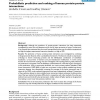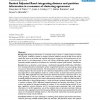BMCBI
2007
14 years 20 days ago
2007
Background: Domains are the basic functional units of proteins. It is believed that protein-protein interactions are realized through domain interactions. Revealing multi-domain c...
BMCBI
2007
14 years 20 days ago
2007
Background: Although the prediction of protein-protein interactions has been extensively investigated for yeast, few such datasets exist for the far larger proteome in human. Furt...
BMCBI
2007
14 years 20 days ago
2007
Background: The systematic analysis of protein-protein interactions can enable a better understanding of cellular organization, processes and functions. Functional modules can be ...
BMCBI
2007
14 years 20 days ago
2007
Background: Biological information is commonly used to cluster or classify entities of interest such as genes, conditions, species or samples. However, different sources of data c...
BMCBI
2007
14 years 20 days ago
2007
Background: Protein-protein interactions are critical for cellular functions. Recently developed computational approaches for predicting protein-protein interactions utilize co-ev...
BMCBI
2007
14 years 20 days ago
2007
BMCBI
2007
14 years 20 days ago
2007
Background: Odorant binding proteins (OBPs) are believed to shuttle odorants from the environment to the underlying odorant receptors, for which they could potentially serve as od...
BMCBI
2007
14 years 20 days ago
2007
Background: Transcriptional modules (TM) consist of groups of co-regulated genes and transcription factors (TF) regulating their expression. Two high-throughput (HT) experimental ...
BMCBI
2007
14 years 20 days ago
2007
Background: Current approaches to parameter estimation are often inappropriate or inconvenient for the modelling of complex biological systems. For systems described by nonlinear ...
BMCBI
2007
14 years 20 days ago
2007
Background: The aim of this paper is to demonstrate the application of watermarks based on DNA sequences to identify the unauthorized use of genetically modified organisms (GMOs) ...





